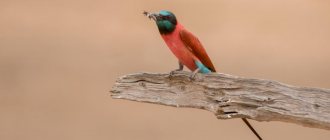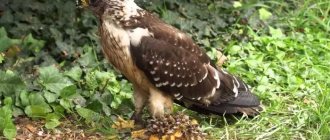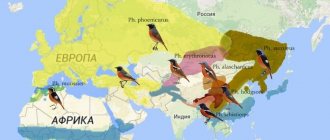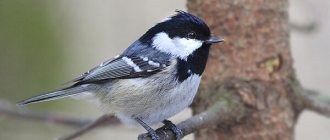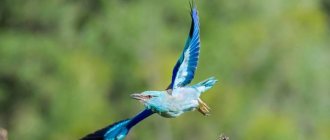Description and features
The bee-eater is a small, bright bird of the bee-eater family. This family of heavenly inhabitants is recognized as the most beautiful in Europe. And not without reason. It’s hard not to admire the color of the bee-eater. Feathers are painted in red, green, yellow, blue and their shades.
Each species has its own characteristics of color distribution in plumage. Based on this characteristic, as well as their habitat, more than 20 species of birds are distinguished. Like most birds, males are more beautiful and brighter than females. With age, the color of the feathers becomes brighter. The bee-eater fits in the palm of your hand. Its body length is about 26 cm. The most beautiful bird in Europe weighs from 20 to 50 grams.
At the same time, the baby needs 40 grams of food per day! A distinctive feature of bee-eaters is their beak. It is long in comparison with the body, slightly curved. The beak is the main hunting tool for most birds. That is why lovers of eating insects have developed such an elegant tool during evolution.
Bee-eaters got their name from their characteristic call: “Schur-Schur.” Brightly colored birds are often considered symbols of good luck. The bee-eater is no exception. In many countries where it is not considered an apiary destroyer, meeting a bright bird brings good luck, according to popular belief.
Such a country in Europe is France. And in Egypt and on the island of Crete, not only an encounter with bee-eating bee-eater , but also cooking it for food is considered a good sign. People who practice this argue that if you also eat a lucky sign, then happiness will increase to a greater extent.
Shrike
Shrikes are bee-eating birds that lead a predatory lifestyle. The main habitat extends across Eurasia. One species is found in North America. Birds choose open spaces for living and high places for observation (lonely trees, pillars).
The main feature of the appearance is the beak, compressed on the sides, the end of which is bent in the form of a hook. Color depends on the species. Gray, rufous, red-headed, and black-fronted shrikes are common. The average length is 20–25 cm. At moderate latitudes, the plumage color of birds is less bright, gray, black, red and white shades are observed.
Shrikes eat large insects, which include bees, small mammals, lizards, and birds. Peculiarities:
- voracity;
- nesting in pairs;
- nomadic or migratory lifestyle.
The presence of several individuals near a farm causes significant damage. Therefore, it is necessary to exterminate the shrikes or change the site. Particularly dangerous in summer.
Kinds
The bee-eater family has dozens of species. Birds are differentiated mainly by plumage and habitat.
1. White-throated bee-eater . The plumage is predominantly green, the breast is golden tones. The chin is separated by a black stripe. Red eyes are emphasized with a black “mask”. The crown is also black. It prefers to spend the summer in semi-deserts near the Sahara Desert, and winter in tropical forests. The length of the bird reaches 20 cm, and the weight does not exceed 30 grams.
2. Golden bee-eater . This species is the brightest in the family. The back is red, the chest is blue, and there are splashes of yellow, red, blue and green on the wings. The chin is yellow, and there is a black stripe on the red eyes.
The golden bee-eater is the most common species in the family. In winter it can be found in India. In summer, its habitat expands significantly. Many researchers have observed the golden bee-eater in the southern parts of temperate latitudes.
3. Bee-eater . The species is named after the German explorer Richard Boehm, who explored the Zanzibar region in the late 19th century. Otherwise, this bird is called the green bee-eater. The length of the bee-eater is 17 cm, and the weight is 20 grams. Green color predominates in its plumage.
The chest of the bee-eater is painted a warmer shade, and the back has dark green and emerald feathers. The cap and throat are red. The eyes have a characteristic black stripe on the eyes. The bee-eater lives in Africa. Settles in equatorial forests, where there is a lot of light. The selection criterion for it is the presence of mopane wood.
4. Black-headed bee-eater . This species can be called large compared to its relatives. Body length – 28 cm, weight – 54 g. Bee-eaters got their name from their color. The bird's head is completely painted black, which makes the birds seem menacing.
The back, wings and tail are painted in shades of green. The chest and abdomen are yellow and orange. The black-headed bee-eater lives in Africa, in Nigeria, Gabon, Angola, Congo and other adjacent countries.
5. White-fronted bee-eater . The plumage of this species contains an unusually large number of colors. The name comes from the white plumage on the head above and below the characteristic black eye stripe. The chin is scarlet, the chest and abdomen are yellow. Closer to the tail, the plumage becomes indigo color.
The back and wings are green, like most members of the family. White-fronted bee-eaters have rounded wings. The body length is 23 cm, and the weight does not exceed 40 g. The white-fronted bee-eater lives in African savannas.
6. Red-throated bee-eater . This species seems to combine the golden and white-fronted bee-eaters. A distinctive feature is the red chin. The forehead is green. The back of the head is yellow-orange, the wings, tail and back are green, the lower part of the tail is deep blue. It lives in Africa in areas from Sinegal to the Central African Republic and from Ethiopia to Uganda.
7. Black bee-eater . The description of the plumage of this bird is simple compared to its relatives. The throat is red, and there are bright blue feathers on the forehead and tail. Basically, the bird is black.
8. Swallow-tailed bee-eater . From the name you can understand what the main feature of this species is. The color of the back, wings and cap is green. The tail is blue, with black spots at the end. The throat is yellow. The length of the body including the tail is 20 cm. The habitat is mainly south of the Sahara, in the African savannas.
9. Brown-headed bee-eater . The appearance of the bird is strict and solemn at the same time. The wings and back are dark green, approaching black. The chest is light green, blue spots appear closer to the tail. The cap is burgundy, the throat is bright yellow, separated from the chest by a thin strip of wine color. Body length – 20 cm, weight – about 30 g.
10. Pink bee-eater . The bird got its name from its dark pink chin and chest. All other plumage of the bee-eater is dark gray. Under the characteristic black stripe on the eyes there is a white one, creating contrast. It lives in the same area as the black-headed bee-eater.
11. Blue-headed bee-eater . Not only the head, but most of the bird's plumage is blue. The wings are red-brown and there are several bright red feathers under the beak. Black stripe on eyes and neck. The blue-headed bee-eater is a fairly small representative of the family. Its length is only 19 cm, and its weight does not exceed 30g.
12. Nubian bee-eater . An incredibly bright and contrasting representative of the family is also called the purple bee-eater or red bee-eater . The forehead and chin are blue, all other plumage is pink, interspersed with red, green, blue and brown. Body length is 40cm. In summer it lives in the north and south of Africa, and in winter - in the equator region. Prefers savannas and river valleys, and does not ignore mangroves.
13. Rainbow bee-eater . The peculiarity of the bird is not only the abundance of colors in its plumage, but also the smooth transitions between shades. On the back, yellow, green, and blue colors predominate; on the wings, green gives way to red. All shades are present on the head. Rainbow bee-eaters live in Australia and on the island of Tasmania. Experiences the winter in New Guinea.
In addition to the described species, there are also dwarf, Somali, olive, blue-breasted and Malayan bee-eaters. They all differ from each other in plumage and habitat. It is hardly possible to say which bee-eater is the most beautiful, because each species has its own unique, inimitable and surprising characteristics. The bee-eater photos in the wild look incredible. It's a pleasure to look at their plumage.
Golden Bee-eater in the Red Book
The European bee-eater is included in the list of protected species in the international Red Book. On the territory of the Russian Federation, the bee eater is listed as a protected species only in the southern regions of the country.
Main causes of extinction
The main reasons for the extinction of the golden bee-eater include:
- reducing the volume of food supply (destruction of insects);
- destruction of habitual nesting areas;
- mass shooting by beekeepers due to damage to the farm.
It is known that the total damage to beekeeping from bee eaters is no more than 0.5%, but this does not reduce the specific damage to individual farms. Mass shooting negatively affects the general condition of the bird population.
The bee-eater population is subject to severe hunting in Morocco, Greece, Spain and Cyprus. The population of the cities of the Nile River Delta use bee-eater for food. In Russia, Belarus and Ukraine you can also find a radically negative attitude of beekeepers towards bird colonies.
Current population situation
At the moment, the greatest negative impact on the state of the bird population, in addition to direct extermination, is exerted by naturalists and urban noise. Due to increased anxiety, the bee-eater feeds its chicks less often, which has a bad effect on their growth and development.
It is known that the size of the range is directly related to the number of individuals in the population; the more birds in the colony and the better its condition, the more the nesting territory expands in the northern direction.
Do you need to take protective measures?
Currently, in the area where bee eaters live, environmental conservation is being promoted among the population, as well as work is being done to reduce the amount of insecticides used in the fight against insects (food supply).
Lifestyle and habitat
The homeland of birds is the tropics and semi-deserts. This is why bee-eaters are so colorful. The largest habitat area is Africa, but some representatives are also found in subtropical and temperate European latitudes. In Russia, the habitat of birds does not extend north of the Tambov and Ryazan regions. The bee-eater can be found on the island of Madagascar and New Guinea, Australia and Asia.
Bee-eaters fly quickly. This helps them hunt for food in the air. Insects are the favorite food of colorful birds. Larvae, caterpillars, dragonfly butterflies - all of them are wary of bee-eaters. The large weight or impressive size of the insect does not bother small birds at all.
Most of all, bee-eaters like wasps and bees, which they remove their stings before eating. Due to their addiction to this type of insect, bee-eaters can threaten to destroy entire apiaries! During the Soviet Union, there was a decree on the extermination of bee-eaters in order to preserve beekeeping farms. And in our time, they try to keep birds away from apiaries. However, it was found that bee-eaters do not destroy even a percentage of dying bees per year.
First, a thunderstorm of insects examines prey from a high place. This could be a pole or fence, the roof of a house, or a tree branch that offers a good view. In flight, the bird grabs prey, kills it with a blow to the ground, tears off its wings, sting and other organs that interfere with consumption.
In some regions, bee-eaters are included in the Red Book. It would seem that birds with such bright plumage settle in trees. But they prefer burrows in open spaces. The habitat can be cliffs, abandoned quarries, deserted or quiet villages. The main thing is to be able to arrange a hole. This makes bee-eaters similar to shore swallows.
Bee-eaters do not like loneliness, so they live in flocks. During the breeding season, huge flocks, which can number up to a thousand individuals, are divided into pairs. However, this does not weaken their unity. In case of trouble, the birds help each other.
An important part of the bird's lifestyle is water procedures. Due to the fact that birds live in warm latitudes, parasites can appear in their plumage. This is why bee-eaters spend a lot of time in sand and water baths. They love to bask in the sun, smoothing their feathers, paying attention to each of them.
Lifestyle
In the spring, at the beginning of May, flocks of bee-eaters gather at nesting sites. Colonies can number from 5 to 1000 individuals. Having arrived at the nesting site, the bee-eaters split into pairs, but do not lose their collective spirit - if one pair has trouble, the nest is disturbed, then the rest will anxiously fly around and express condolences or concern.
For their residence within the range, bee-eaters choose open steppes along the edge of a quarry, pit or ravine. They can nest on high steep river banks or in river valleys. They avoid noisy cities, but can choose to settle in the outskirts with old, destroyed buildings, in the thick walls of which they can build a nest.
The bee-eater is a migratory bird, and during migration it gathers in mixed flocks of up to several hundred individuals. Young and adult birds stay close to their habitat for some time before leaving, then they begin to fly further and further and fly beyond their range.
Until autumn, migrations continue, which smoothly turn into the departure of the bird. Until mid-September, active migration of bee-eaters can be observed. The bee-eater winters in the southwest coast of Africa and in South Africa.
Reproduction and lifespan
The bee-eater's nest is a long horizontal hole. It is mainly the male who digs it. A tunnel is laid with a depth of 1-1.5 m and a diameter of 5 cm. About 7 kg of soil are thrown out by the birds during the digging process. Construction work takes up to two weeks. The birds work in approaches: they dig for an hour or two, and then take a break of the same length.
A dug hole is a subject of quarrels between relatives. Not every bird wants to dig such a hole if it can be done by force. A couple of individuals who decide to create offspring have to reclaim their home.
The main criterion when choosing a male to create offspring is the ability to feed the chicks. That is why suitors treat the female as abundantly as possible. After the female makes a choice, mating occurs. A clutch can contain from 4 to 10 eggs. They are very small, initially pinkish in color. As it incubates, the color becomes more faded.
The eggs are incubated by the female, and the male provides food. Sometimes future parents change roles. And this happens for about a month. The chicks are born completely naked. They begin to feed heavily from the first days, natural selection occurs, and the weakest chicks die due to lack of nutrition.
A month later, the chicks leave the parental nest. Young relatives from previous broods eaters raise their chicks They obtain food for their younger brothers and help protect their homes from predators.
Unlike most representatives of birds, bee-eaters do not care about the “floor” cover of the nest. They do not carry straws, fluff and leaves into the hole. During the brooding process, the female regurgitates undigested remains of insects: wings, legs, which form an excellent bedding for the offspring.
Birds of prey do not pose a threat to bee-eater clutches. This is facilitated by deep burrows, on the construction of which birds spend a lot of time and effort. The nest may be disturbed by dogs or foxes. However, one egg weighs 5-7 grams, and even a large clutch is not able to satiate the predator. Life expectancy is about 4 years.
Interesting facts about the bird
The European bee-eater is an amazing creature of nature that lives side by side with humans.
What else is known about bee eaters:
- The maximum age of a bird caught in Europe is 5 years and 11 months. The average lifespan of a bird is 4 years.
- The bee-eater's vision allows it to spot prey from a distance of 100 meters.
- When removing the stinger from a dangerous insect, the bird closes its eyes due to the risk of injury.
- Near the main burrow there are often several unfinished ones where the male spends the night.
- Immediately after laying, the eggs have a pinkish color and an almost transparent shell.
- If the female dies before the end of incubation, the male takes over her role and completely supports and trains the chicks, to the detriment of his own weight and health. Often, by the time the chicks grow up, the weight of the male drops to the lower level of the norm.
- Loyalty to a partner in bee-eater pairs is 88% (very rare pair changes).
- A family of bee eaters consisting of a pair of parents and immature young from the previous clutch can reach 12 individuals.
- One of the entertainments of birds in urban environments is knocking on power wires in order to produce a ringing sound.
Bee-eaters are wonderful representatives of the fauna that surrounds humans. Their social abilities and interaction among several generations cannot leave any naturalist indifferent.
Less serious pests
There are even less dangerous enemies of bees in nature; you also shouldn’t forget about them in order to be as prepared as possible for all surprises.
- Ham skin beetles. They settle in the hive and begin to eat the brood and beebread. From them it is enough to treat the house with sulfur dioxide. Don't forget to resettle the bees first!
- Earwigs. They feed on dead insects and beebread, hiding in the insulation, so it will be enough to change the material and coat the legs of the house well with grease.
- Spiders. They should be removed as soon as you see them, as the spider can eat up to seven bees a day! They try to hide next to the entrance to catch flying insects in the web.
When she appears in the apiary
Considering that the end of May is the time of nesting and for 3-4 weeks all thoughts are about the offspring, you can observe the bee-eater in the apiary and over the fields from the beginning of July to September. At this time, beekeepers need to be extremely careful and begin to build protective structures against bee-eater attacks.
It’s not just that farmers, in addition to planting, and then endlessly weeding the beds and harvesting, also have to devote their energy to fighting pests that strive to destroy everything that is so carefully created by human hands.
Buzzard
The honey buzzard (bee eater) is a bird of prey belonging to the hawk family. Lives in Asia and Europe. They lead a migratory lifestyle. In September they fly to Africa and return only in May.
The appearance of honey beetles is large in size up to 60 cm, with a wingspan of up to 1.2 m, and a weight of up to 1 kg. The tail is long, the feathers around the eyes form a scaly pattern. The color of the dorsal part is dark brown, the color changes in front, sometimes rare longitudinal or transverse strokes appear.
Bee-eating birds stir up wasp nests and look for insect larvae. The brood of wild bees and bumblebees is suitable for food. The diet also includes lizards, frogs, and rodents. Buzzards rarely visit apiaries.
Nutrition
The bee-eater eats berries, plant buds, various seeds of grasses and coniferous trees, and in some cases catches insects, thus supplementing its diet. But the main source of food for such birds is trees, which is why the presence of forests in a certain area becomes the main condition for their successful survival.
Such birds sometimes seem clumsy, giving the impression of being leisurely and plump, but in the process of finding food for themselves they are very skillful and show miracles of dexterity. In order to reach the desired fruits, sprouts or buds, squeezing through tree branches, they often have to twist, take awkward positions, stretch out as far as their height allows, and masterfully grab with their beaks the saving twigs that are in their way.
But after they have had their fill, the gullible birds apathetically freeze in some position, resting, in their carelessness without even thinking about their own safety. And so their time passes until the moment when they get hungry again. And then they set off again, sometimes alone, and sometimes in small groups, in search of food, again turning from short-sighted bumpkins into dodgers.
